Nursing and Epidemiology Essay: Historical Event & Measles Control
VerifiedAdded on 2022/09/17
|13
|3447
|32
Essay
AI Summary
This essay delves into the field of epidemiology, examining a significant historical event, the British Doctors' Study, and its profound impact on public health. The study, conducted by British physicians, established a clear link between tobacco smoking and various respiratory diseases, particularly lung cancer, fundamentally altering perceptions and policies regarding smoking. The essay then shifts its focus to the communicable disease of measles, exploring its epidemiology, transmission, and preventive measures, including vaccination strategies. It highlights the importance of epidemiological surveillance, laboratory testing, and public health interventions in controlling measles outbreaks and promoting health literacy. The discussion includes the challenges of measles elimination, particularly in the context of vaccine hesitancy, and emphasizes the need for comprehensive approaches involving healthcare professionals, educational institutions, and community engagement to effectively manage and prevent the spread of the disease. Furthermore, the essay highlights the role of the World Health Organization (WHO) and government guidelines for controlling measles outbreaks.
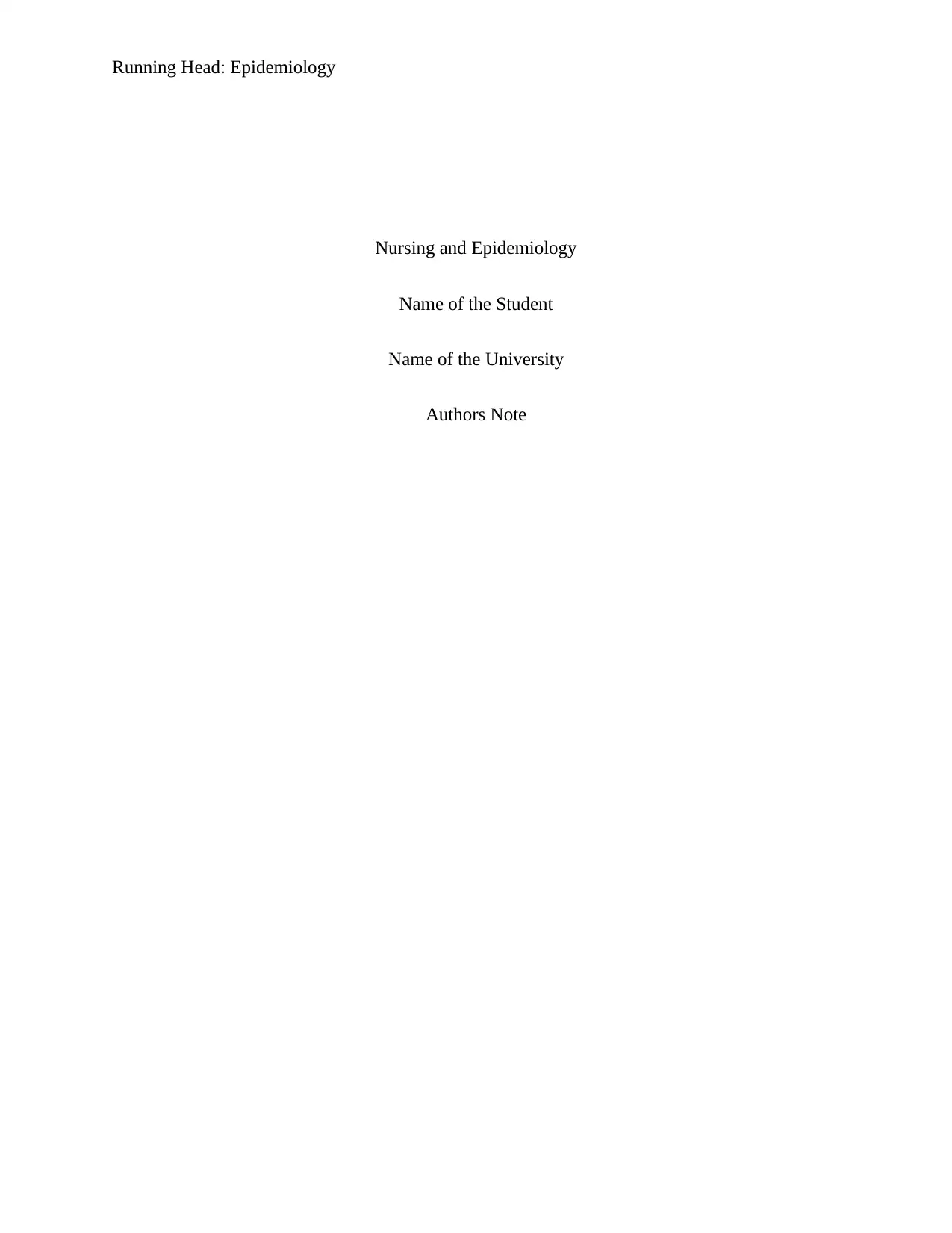
Running Head: Epidemiology
Nursing and Epidemiology
Name of the Student
Name of the University
Authors Note
Nursing and Epidemiology
Name of the Student
Name of the University
Authors Note
Paraphrase This Document
Need a fresh take? Get an instant paraphrase of this document with our AI Paraphraser
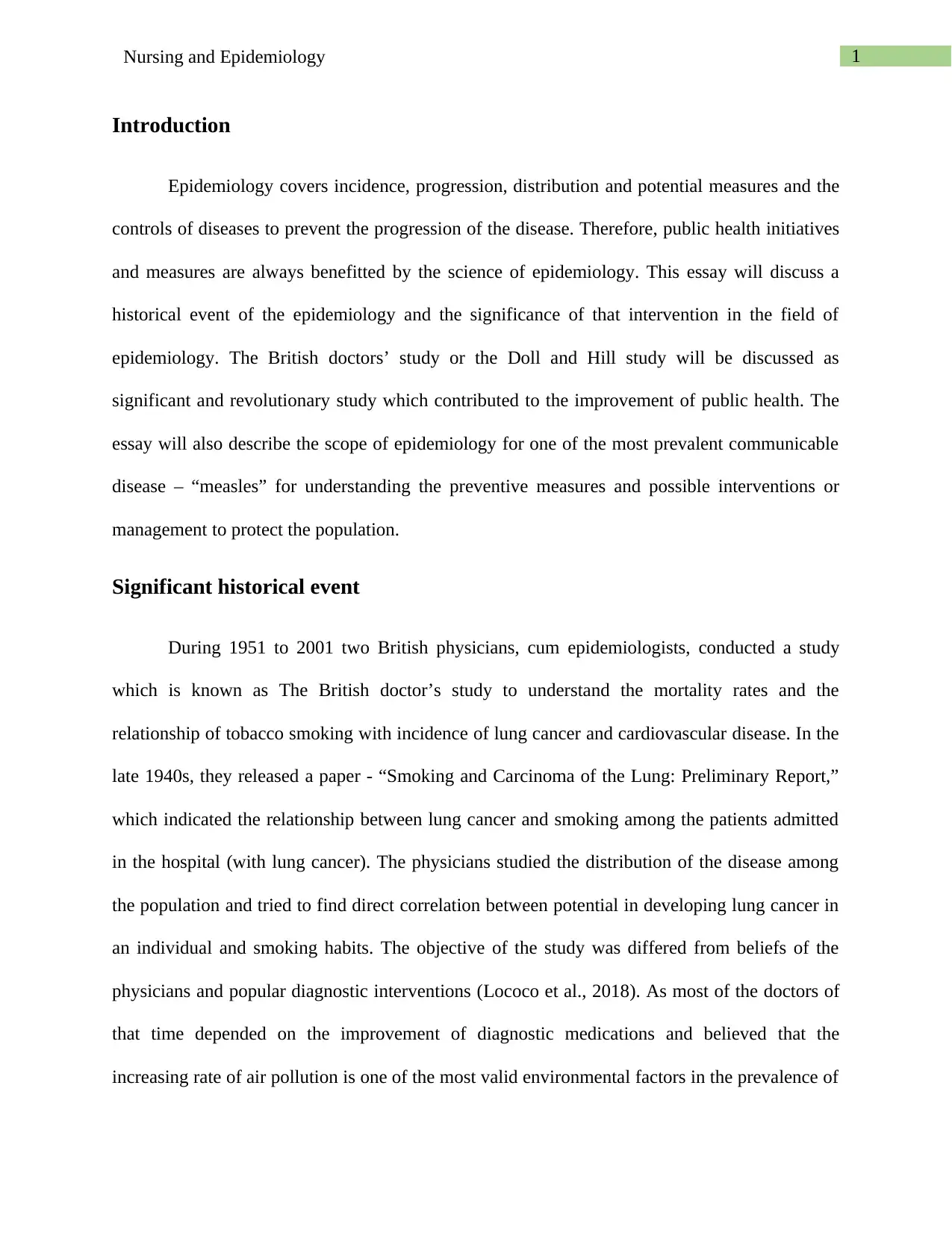
1Nursing and Epidemiology
Introduction
Epidemiology covers incidence, progression, distribution and potential measures and the
controls of diseases to prevent the progression of the disease. Therefore, public health initiatives
and measures are always benefitted by the science of epidemiology. This essay will discuss a
historical event of the epidemiology and the significance of that intervention in the field of
epidemiology. The British doctors’ study or the Doll and Hill study will be discussed as
significant and revolutionary study which contributed to the improvement of public health. The
essay will also describe the scope of epidemiology for one of the most prevalent communicable
disease – “measles” for understanding the preventive measures and possible interventions or
management to protect the population.
Significant historical event
During 1951 to 2001 two British physicians, cum epidemiologists, conducted a study
which is known as The British doctor’s study to understand the mortality rates and the
relationship of tobacco smoking with incidence of lung cancer and cardiovascular disease. In the
late 1940s, they released a paper - “Smoking and Carcinoma of the Lung: Preliminary Report,”
which indicated the relationship between lung cancer and smoking among the patients admitted
in the hospital (with lung cancer). The physicians studied the distribution of the disease among
the population and tried to find direct correlation between potential in developing lung cancer in
an individual and smoking habits. The objective of the study was differed from beliefs of the
physicians and popular diagnostic interventions (Lococo et al., 2018). As most of the doctors of
that time depended on the improvement of diagnostic medications and believed that the
increasing rate of air pollution is one of the most valid environmental factors in the prevalence of
Introduction
Epidemiology covers incidence, progression, distribution and potential measures and the
controls of diseases to prevent the progression of the disease. Therefore, public health initiatives
and measures are always benefitted by the science of epidemiology. This essay will discuss a
historical event of the epidemiology and the significance of that intervention in the field of
epidemiology. The British doctors’ study or the Doll and Hill study will be discussed as
significant and revolutionary study which contributed to the improvement of public health. The
essay will also describe the scope of epidemiology for one of the most prevalent communicable
disease – “measles” for understanding the preventive measures and possible interventions or
management to protect the population.
Significant historical event
During 1951 to 2001 two British physicians, cum epidemiologists, conducted a study
which is known as The British doctor’s study to understand the mortality rates and the
relationship of tobacco smoking with incidence of lung cancer and cardiovascular disease. In the
late 1940s, they released a paper - “Smoking and Carcinoma of the Lung: Preliminary Report,”
which indicated the relationship between lung cancer and smoking among the patients admitted
in the hospital (with lung cancer). The physicians studied the distribution of the disease among
the population and tried to find direct correlation between potential in developing lung cancer in
an individual and smoking habits. The objective of the study was differed from beliefs of the
physicians and popular diagnostic interventions (Lococo et al., 2018). As most of the doctors of
that time depended on the improvement of diagnostic medications and believed that the
increasing rate of air pollution is one of the most valid environmental factors in the prevalence of
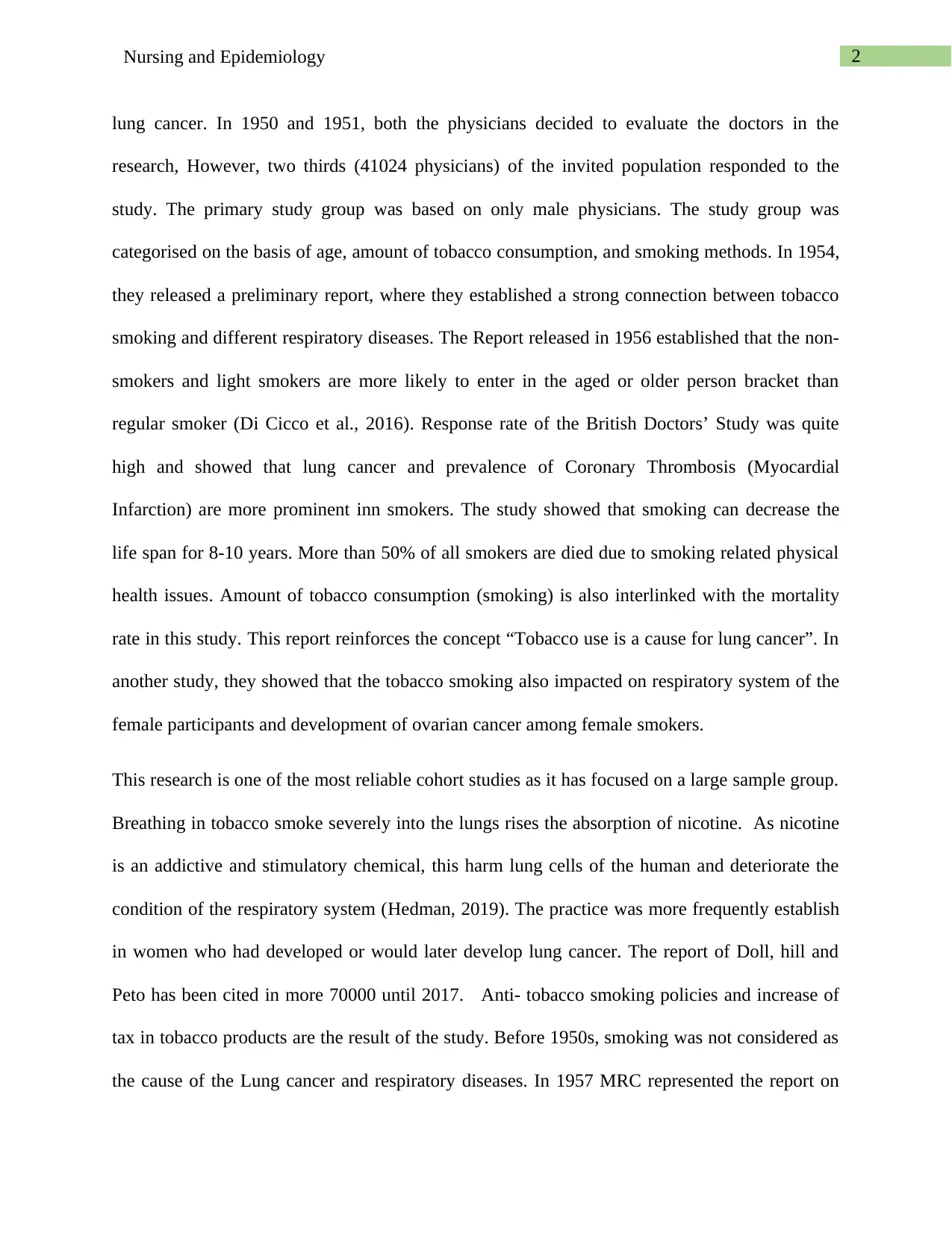
2Nursing and Epidemiology
lung cancer. In 1950 and 1951, both the physicians decided to evaluate the doctors in the
research, However, two thirds (41024 physicians) of the invited population responded to the
study. The primary study group was based on only male physicians. The study group was
categorised on the basis of age, amount of tobacco consumption, and smoking methods. In 1954,
they released a preliminary report, where they established a strong connection between tobacco
smoking and different respiratory diseases. The Report released in 1956 established that the non-
smokers and light smokers are more likely to enter in the aged or older person bracket than
regular smoker (Di Cicco et al., 2016). Response rate of the British Doctors’ Study was quite
high and showed that lung cancer and prevalence of Coronary Thrombosis (Myocardial
Infarction) are more prominent inn smokers. The study showed that smoking can decrease the
life span for 8-10 years. More than 50% of all smokers are died due to smoking related physical
health issues. Amount of tobacco consumption (smoking) is also interlinked with the mortality
rate in this study. This report reinforces the concept “Tobacco use is a cause for lung cancer”. In
another study, they showed that the tobacco smoking also impacted on respiratory system of the
female participants and development of ovarian cancer among female smokers.
This research is one of the most reliable cohort studies as it has focused on a large sample group.
Breathing in tobacco smoke severely into the lungs rises the absorption of nicotine. As nicotine
is an addictive and stimulatory chemical, this harm lung cells of the human and deteriorate the
condition of the respiratory system (Hedman, 2019). The practice was more frequently establish
in women who had developed or would later develop lung cancer. The report of Doll, hill and
Peto has been cited in more 70000 until 2017. Anti- tobacco smoking policies and increase of
tax in tobacco products are the result of the study. Before 1950s, smoking was not considered as
the cause of the Lung cancer and respiratory diseases. In 1957 MRC represented the report on
lung cancer. In 1950 and 1951, both the physicians decided to evaluate the doctors in the
research, However, two thirds (41024 physicians) of the invited population responded to the
study. The primary study group was based on only male physicians. The study group was
categorised on the basis of age, amount of tobacco consumption, and smoking methods. In 1954,
they released a preliminary report, where they established a strong connection between tobacco
smoking and different respiratory diseases. The Report released in 1956 established that the non-
smokers and light smokers are more likely to enter in the aged or older person bracket than
regular smoker (Di Cicco et al., 2016). Response rate of the British Doctors’ Study was quite
high and showed that lung cancer and prevalence of Coronary Thrombosis (Myocardial
Infarction) are more prominent inn smokers. The study showed that smoking can decrease the
life span for 8-10 years. More than 50% of all smokers are died due to smoking related physical
health issues. Amount of tobacco consumption (smoking) is also interlinked with the mortality
rate in this study. This report reinforces the concept “Tobacco use is a cause for lung cancer”. In
another study, they showed that the tobacco smoking also impacted on respiratory system of the
female participants and development of ovarian cancer among female smokers.
This research is one of the most reliable cohort studies as it has focused on a large sample group.
Breathing in tobacco smoke severely into the lungs rises the absorption of nicotine. As nicotine
is an addictive and stimulatory chemical, this harm lung cells of the human and deteriorate the
condition of the respiratory system (Hedman, 2019). The practice was more frequently establish
in women who had developed or would later develop lung cancer. The report of Doll, hill and
Peto has been cited in more 70000 until 2017. Anti- tobacco smoking policies and increase of
tax in tobacco products are the result of the study. Before 1950s, smoking was not considered as
the cause of the Lung cancer and respiratory diseases. In 1957 MRC represented the report on
⊘ This is a preview!⊘
Do you want full access?
Subscribe today to unlock all pages.

Trusted by 1+ million students worldwide
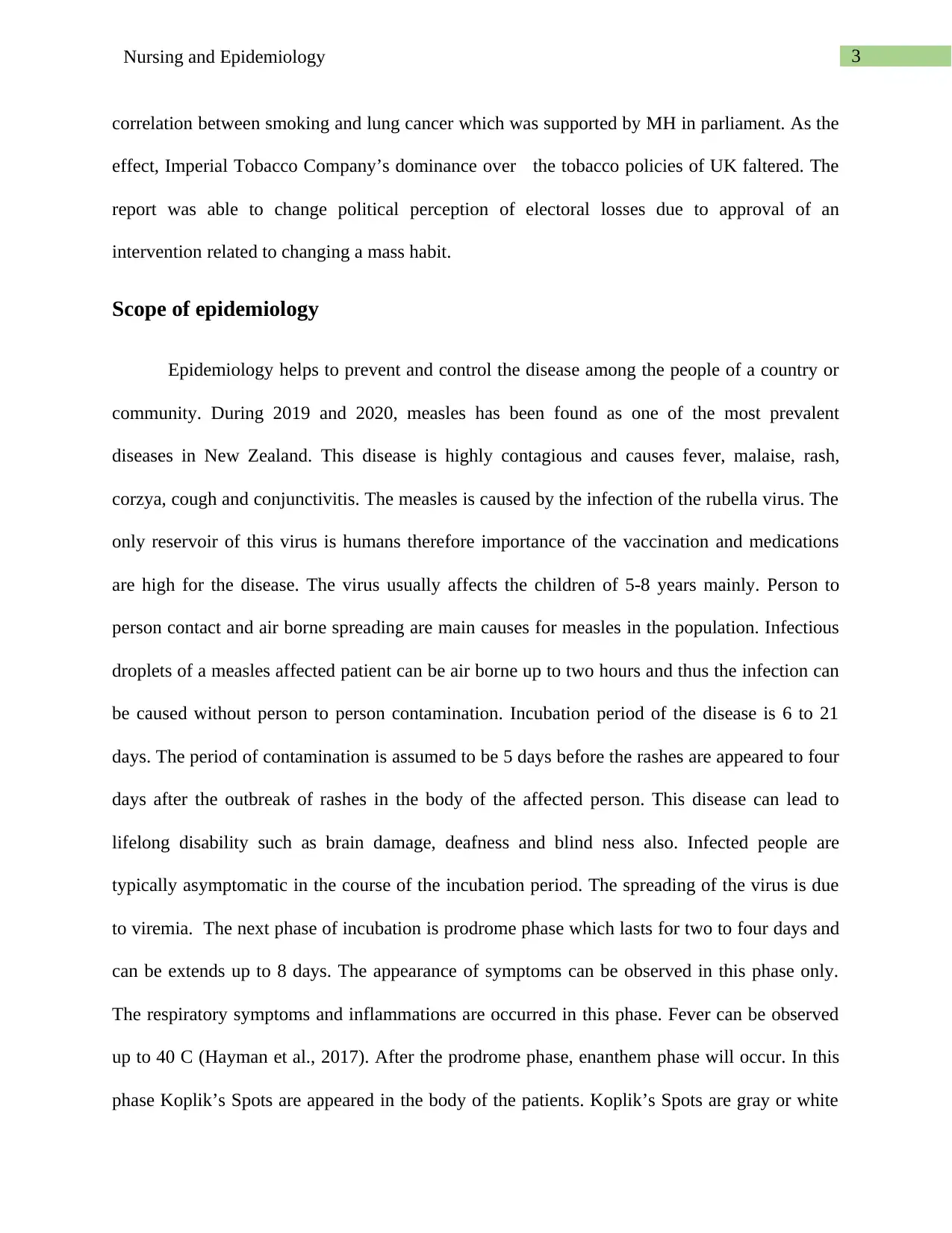
3Nursing and Epidemiology
correlation between smoking and lung cancer which was supported by MH in parliament. As the
effect, Imperial Tobacco Company’s dominance over the tobacco policies of UK faltered. The
report was able to change political perception of electoral losses due to approval of an
intervention related to changing a mass habit.
Scope of epidemiology
Epidemiology helps to prevent and control the disease among the people of a country or
community. During 2019 and 2020, measles has been found as one of the most prevalent
diseases in New Zealand. This disease is highly contagious and causes fever, malaise, rash,
corzya, cough and conjunctivitis. The measles is caused by the infection of the rubella virus. The
only reservoir of this virus is humans therefore importance of the vaccination and medications
are high for the disease. The virus usually affects the children of 5-8 years mainly. Person to
person contact and air borne spreading are main causes for measles in the population. Infectious
droplets of a measles affected patient can be air borne up to two hours and thus the infection can
be caused without person to person contamination. Incubation period of the disease is 6 to 21
days. The period of contamination is assumed to be 5 days before the rashes are appeared to four
days after the outbreak of rashes in the body of the affected person. This disease can lead to
lifelong disability such as brain damage, deafness and blind ness also. Infected people are
typically asymptomatic in the course of the incubation period. The spreading of the virus is due
to viremia. The next phase of incubation is prodrome phase which lasts for two to four days and
can be extends up to 8 days. The appearance of symptoms can be observed in this phase only.
The respiratory symptoms and inflammations are occurred in this phase. Fever can be observed
up to 40 C (Hayman et al., 2017). After the prodrome phase, enanthem phase will occur. In this
phase Koplik’s Spots are appeared in the body of the patients. Koplik’s Spots are gray or white
correlation between smoking and lung cancer which was supported by MH in parliament. As the
effect, Imperial Tobacco Company’s dominance over the tobacco policies of UK faltered. The
report was able to change political perception of electoral losses due to approval of an
intervention related to changing a mass habit.
Scope of epidemiology
Epidemiology helps to prevent and control the disease among the people of a country or
community. During 2019 and 2020, measles has been found as one of the most prevalent
diseases in New Zealand. This disease is highly contagious and causes fever, malaise, rash,
corzya, cough and conjunctivitis. The measles is caused by the infection of the rubella virus. The
only reservoir of this virus is humans therefore importance of the vaccination and medications
are high for the disease. The virus usually affects the children of 5-8 years mainly. Person to
person contact and air borne spreading are main causes for measles in the population. Infectious
droplets of a measles affected patient can be air borne up to two hours and thus the infection can
be caused without person to person contamination. Incubation period of the disease is 6 to 21
days. The period of contamination is assumed to be 5 days before the rashes are appeared to four
days after the outbreak of rashes in the body of the affected person. This disease can lead to
lifelong disability such as brain damage, deafness and blind ness also. Infected people are
typically asymptomatic in the course of the incubation period. The spreading of the virus is due
to viremia. The next phase of incubation is prodrome phase which lasts for two to four days and
can be extends up to 8 days. The appearance of symptoms can be observed in this phase only.
The respiratory symptoms and inflammations are occurred in this phase. Fever can be observed
up to 40 C (Hayman et al., 2017). After the prodrome phase, enanthem phase will occur. In this
phase Koplik’s Spots are appeared in the body of the patients. Koplik’s Spots are gray or white
Paraphrase This Document
Need a fresh take? Get an instant paraphrase of this document with our AI Paraphraser
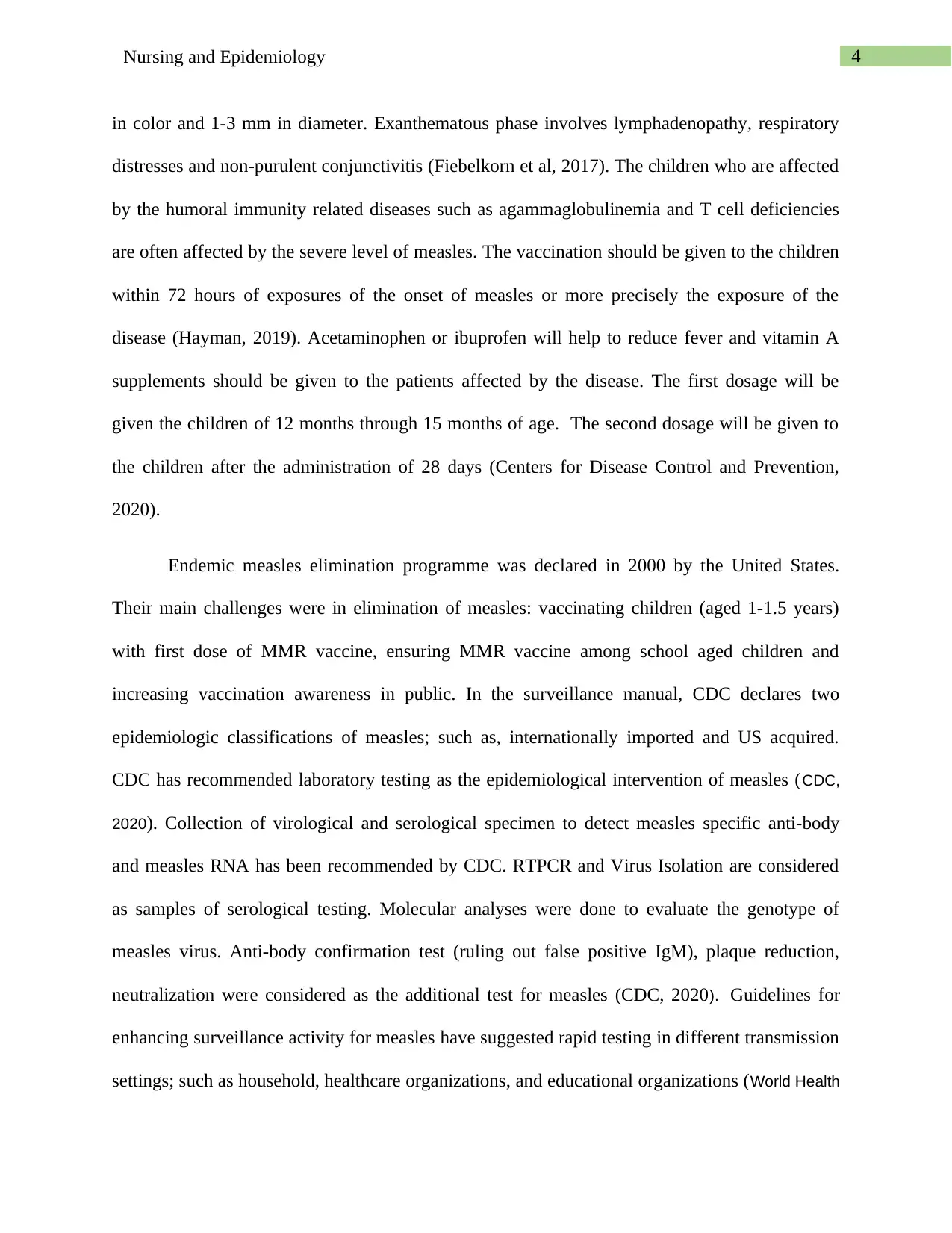
4Nursing and Epidemiology
in color and 1-3 mm in diameter. Exanthematous phase involves lymphadenopathy, respiratory
distresses and non-purulent conjunctivitis (Fiebelkorn et al, 2017). The children who are affected
by the humoral immunity related diseases such as agammaglobulinemia and T cell deficiencies
are often affected by the severe level of measles. The vaccination should be given to the children
within 72 hours of exposures of the onset of measles or more precisely the exposure of the
disease (Hayman, 2019). Acetaminophen or ibuprofen will help to reduce fever and vitamin A
supplements should be given to the patients affected by the disease. The first dosage will be
given the children of 12 months through 15 months of age. The second dosage will be given to
the children after the administration of 28 days (Centers for Disease Control and Prevention,
2020).
Endemic measles elimination programme was declared in 2000 by the United States.
Their main challenges were in elimination of measles: vaccinating children (aged 1-1.5 years)
with first dose of MMR vaccine, ensuring MMR vaccine among school aged children and
increasing vaccination awareness in public. In the surveillance manual, CDC declares two
epidemiologic classifications of measles; such as, internationally imported and US acquired.
CDC has recommended laboratory testing as the epidemiological intervention of measles (CDC,
2020). Collection of virological and serological specimen to detect measles specific anti-body
and measles RNA has been recommended by CDC. RTPCR and Virus Isolation are considered
as samples of serological testing. Molecular analyses were done to evaluate the genotype of
measles virus. Anti-body confirmation test (ruling out false positive IgM), plaque reduction,
neutralization were considered as the additional test for measles (CDC, 2020). Guidelines for
enhancing surveillance activity for measles have suggested rapid testing in different transmission
settings; such as household, healthcare organizations, and educational organizations (World Health
in color and 1-3 mm in diameter. Exanthematous phase involves lymphadenopathy, respiratory
distresses and non-purulent conjunctivitis (Fiebelkorn et al, 2017). The children who are affected
by the humoral immunity related diseases such as agammaglobulinemia and T cell deficiencies
are often affected by the severe level of measles. The vaccination should be given to the children
within 72 hours of exposures of the onset of measles or more precisely the exposure of the
disease (Hayman, 2019). Acetaminophen or ibuprofen will help to reduce fever and vitamin A
supplements should be given to the patients affected by the disease. The first dosage will be
given the children of 12 months through 15 months of age. The second dosage will be given to
the children after the administration of 28 days (Centers for Disease Control and Prevention,
2020).
Endemic measles elimination programme was declared in 2000 by the United States.
Their main challenges were in elimination of measles: vaccinating children (aged 1-1.5 years)
with first dose of MMR vaccine, ensuring MMR vaccine among school aged children and
increasing vaccination awareness in public. In the surveillance manual, CDC declares two
epidemiologic classifications of measles; such as, internationally imported and US acquired.
CDC has recommended laboratory testing as the epidemiological intervention of measles (CDC,
2020). Collection of virological and serological specimen to detect measles specific anti-body
and measles RNA has been recommended by CDC. RTPCR and Virus Isolation are considered
as samples of serological testing. Molecular analyses were done to evaluate the genotype of
measles virus. Anti-body confirmation test (ruling out false positive IgM), plaque reduction,
neutralization were considered as the additional test for measles (CDC, 2020). Guidelines for
enhancing surveillance activity for measles have suggested rapid testing in different transmission
settings; such as household, healthcare organizations, and educational organizations (World Health
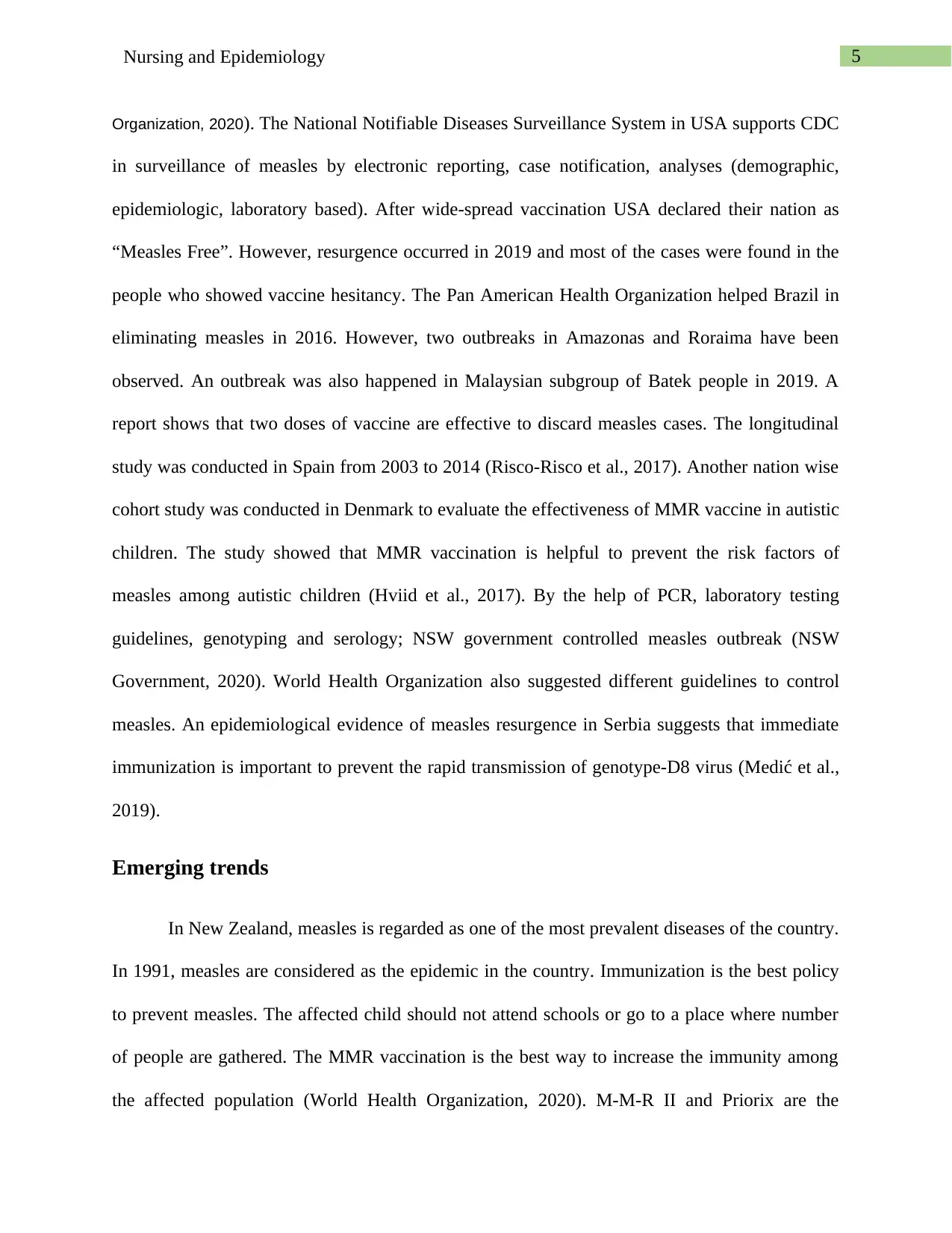
5Nursing and Epidemiology
Organization, 2020). The National Notifiable Diseases Surveillance System in USA supports CDC
in surveillance of measles by electronic reporting, case notification, analyses (demographic,
epidemiologic, laboratory based). After wide-spread vaccination USA declared their nation as
“Measles Free”. However, resurgence occurred in 2019 and most of the cases were found in the
people who showed vaccine hesitancy. The Pan American Health Organization helped Brazil in
eliminating measles in 2016. However, two outbreaks in Amazonas and Roraima have been
observed. An outbreak was also happened in Malaysian subgroup of Batek people in 2019. A
report shows that two doses of vaccine are effective to discard measles cases. The longitudinal
study was conducted in Spain from 2003 to 2014 (Risco-Risco et al., 2017). Another nation wise
cohort study was conducted in Denmark to evaluate the effectiveness of MMR vaccine in autistic
children. The study showed that MMR vaccination is helpful to prevent the risk factors of
measles among autistic children (Hviid et al., 2017). By the help of PCR, laboratory testing
guidelines, genotyping and serology; NSW government controlled measles outbreak (NSW
Government, 2020). World Health Organization also suggested different guidelines to control
measles. An epidemiological evidence of measles resurgence in Serbia suggests that immediate
immunization is important to prevent the rapid transmission of genotype-D8 virus (Medić et al.,
2019).
Emerging trends
In New Zealand, measles is regarded as one of the most prevalent diseases of the country.
In 1991, measles are considered as the epidemic in the country. Immunization is the best policy
to prevent measles. The affected child should not attend schools or go to a place where number
of people are gathered. The MMR vaccination is the best way to increase the immunity among
the affected population (World Health Organization, 2020). M-M-R II and Priorix are the
Organization, 2020). The National Notifiable Diseases Surveillance System in USA supports CDC
in surveillance of measles by electronic reporting, case notification, analyses (demographic,
epidemiologic, laboratory based). After wide-spread vaccination USA declared their nation as
“Measles Free”. However, resurgence occurred in 2019 and most of the cases were found in the
people who showed vaccine hesitancy. The Pan American Health Organization helped Brazil in
eliminating measles in 2016. However, two outbreaks in Amazonas and Roraima have been
observed. An outbreak was also happened in Malaysian subgroup of Batek people in 2019. A
report shows that two doses of vaccine are effective to discard measles cases. The longitudinal
study was conducted in Spain from 2003 to 2014 (Risco-Risco et al., 2017). Another nation wise
cohort study was conducted in Denmark to evaluate the effectiveness of MMR vaccine in autistic
children. The study showed that MMR vaccination is helpful to prevent the risk factors of
measles among autistic children (Hviid et al., 2017). By the help of PCR, laboratory testing
guidelines, genotyping and serology; NSW government controlled measles outbreak (NSW
Government, 2020). World Health Organization also suggested different guidelines to control
measles. An epidemiological evidence of measles resurgence in Serbia suggests that immediate
immunization is important to prevent the rapid transmission of genotype-D8 virus (Medić et al.,
2019).
Emerging trends
In New Zealand, measles is regarded as one of the most prevalent diseases of the country.
In 1991, measles are considered as the epidemic in the country. Immunization is the best policy
to prevent measles. The affected child should not attend schools or go to a place where number
of people are gathered. The MMR vaccination is the best way to increase the immunity among
the affected population (World Health Organization, 2020). M-M-R II and Priorix are the
⊘ This is a preview!⊘
Do you want full access?
Subscribe today to unlock all pages.

Trusted by 1+ million students worldwide
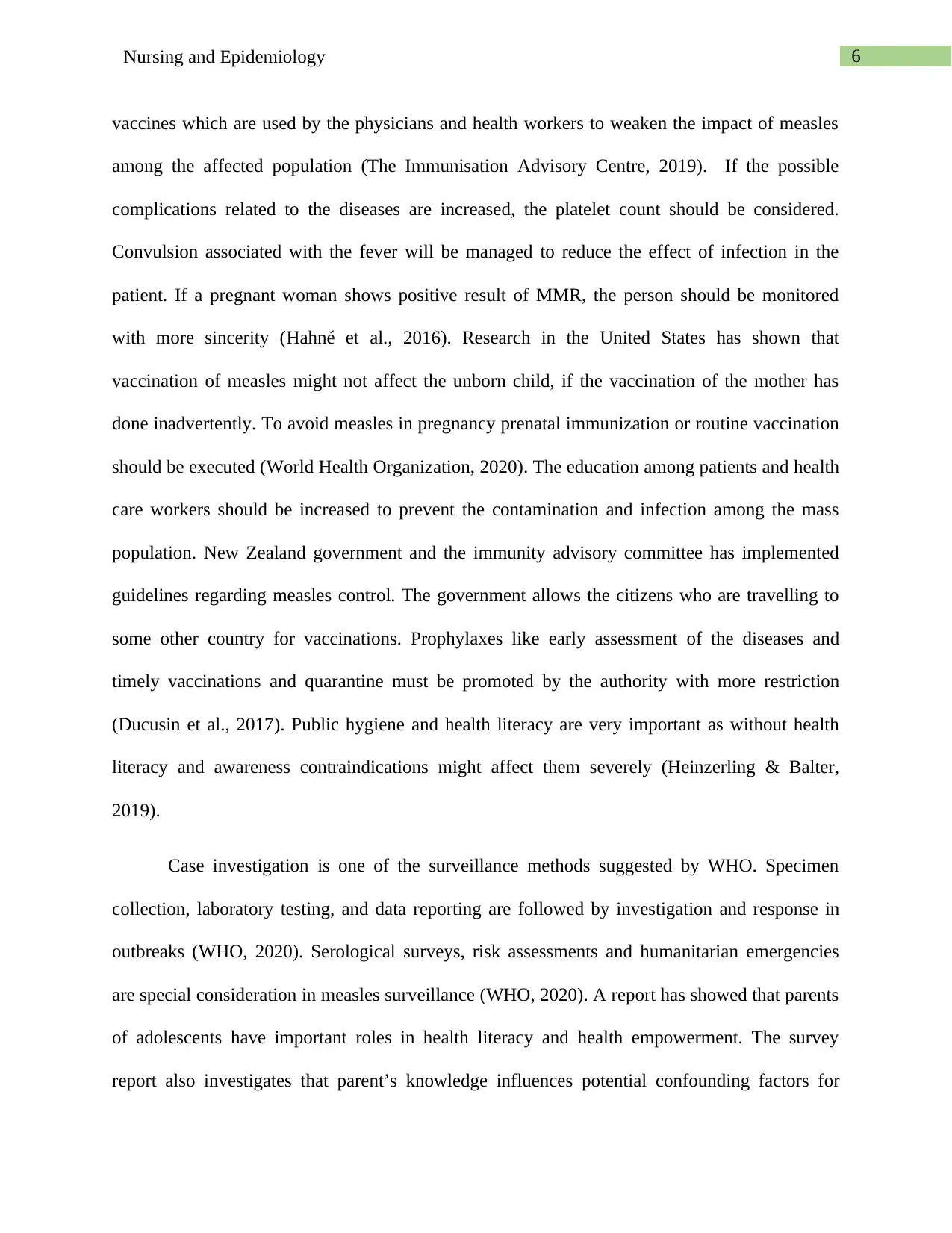
6Nursing and Epidemiology
vaccines which are used by the physicians and health workers to weaken the impact of measles
among the affected population (The Immunisation Advisory Centre, 2019). If the possible
complications related to the diseases are increased, the platelet count should be considered.
Convulsion associated with the fever will be managed to reduce the effect of infection in the
patient. If a pregnant woman shows positive result of MMR, the person should be monitored
with more sincerity (Hahné et al., 2016). Research in the United States has shown that
vaccination of measles might not affect the unborn child, if the vaccination of the mother has
done inadvertently. To avoid measles in pregnancy prenatal immunization or routine vaccination
should be executed (World Health Organization, 2020). The education among patients and health
care workers should be increased to prevent the contamination and infection among the mass
population. New Zealand government and the immunity advisory committee has implemented
guidelines regarding measles control. The government allows the citizens who are travelling to
some other country for vaccinations. Prophylaxes like early assessment of the diseases and
timely vaccinations and quarantine must be promoted by the authority with more restriction
(Ducusin et al., 2017). Public hygiene and health literacy are very important as without health
literacy and awareness contraindications might affect them severely (Heinzerling & Balter,
2019).
Case investigation is one of the surveillance methods suggested by WHO. Specimen
collection, laboratory testing, and data reporting are followed by investigation and response in
outbreaks (WHO, 2020). Serological surveys, risk assessments and humanitarian emergencies
are special consideration in measles surveillance (WHO, 2020). A report has showed that parents
of adolescents have important roles in health literacy and health empowerment. The survey
report also investigates that parent’s knowledge influences potential confounding factors for
vaccines which are used by the physicians and health workers to weaken the impact of measles
among the affected population (The Immunisation Advisory Centre, 2019). If the possible
complications related to the diseases are increased, the platelet count should be considered.
Convulsion associated with the fever will be managed to reduce the effect of infection in the
patient. If a pregnant woman shows positive result of MMR, the person should be monitored
with more sincerity (Hahné et al., 2016). Research in the United States has shown that
vaccination of measles might not affect the unborn child, if the vaccination of the mother has
done inadvertently. To avoid measles in pregnancy prenatal immunization or routine vaccination
should be executed (World Health Organization, 2020). The education among patients and health
care workers should be increased to prevent the contamination and infection among the mass
population. New Zealand government and the immunity advisory committee has implemented
guidelines regarding measles control. The government allows the citizens who are travelling to
some other country for vaccinations. Prophylaxes like early assessment of the diseases and
timely vaccinations and quarantine must be promoted by the authority with more restriction
(Ducusin et al., 2017). Public hygiene and health literacy are very important as without health
literacy and awareness contraindications might affect them severely (Heinzerling & Balter,
2019).
Case investigation is one of the surveillance methods suggested by WHO. Specimen
collection, laboratory testing, and data reporting are followed by investigation and response in
outbreaks (WHO, 2020). Serological surveys, risk assessments and humanitarian emergencies
are special consideration in measles surveillance (WHO, 2020). A report has showed that parents
of adolescents have important roles in health literacy and health empowerment. The survey
report also investigates that parent’s knowledge influences potential confounding factors for
Paraphrase This Document
Need a fresh take? Get an instant paraphrase of this document with our AI Paraphraser
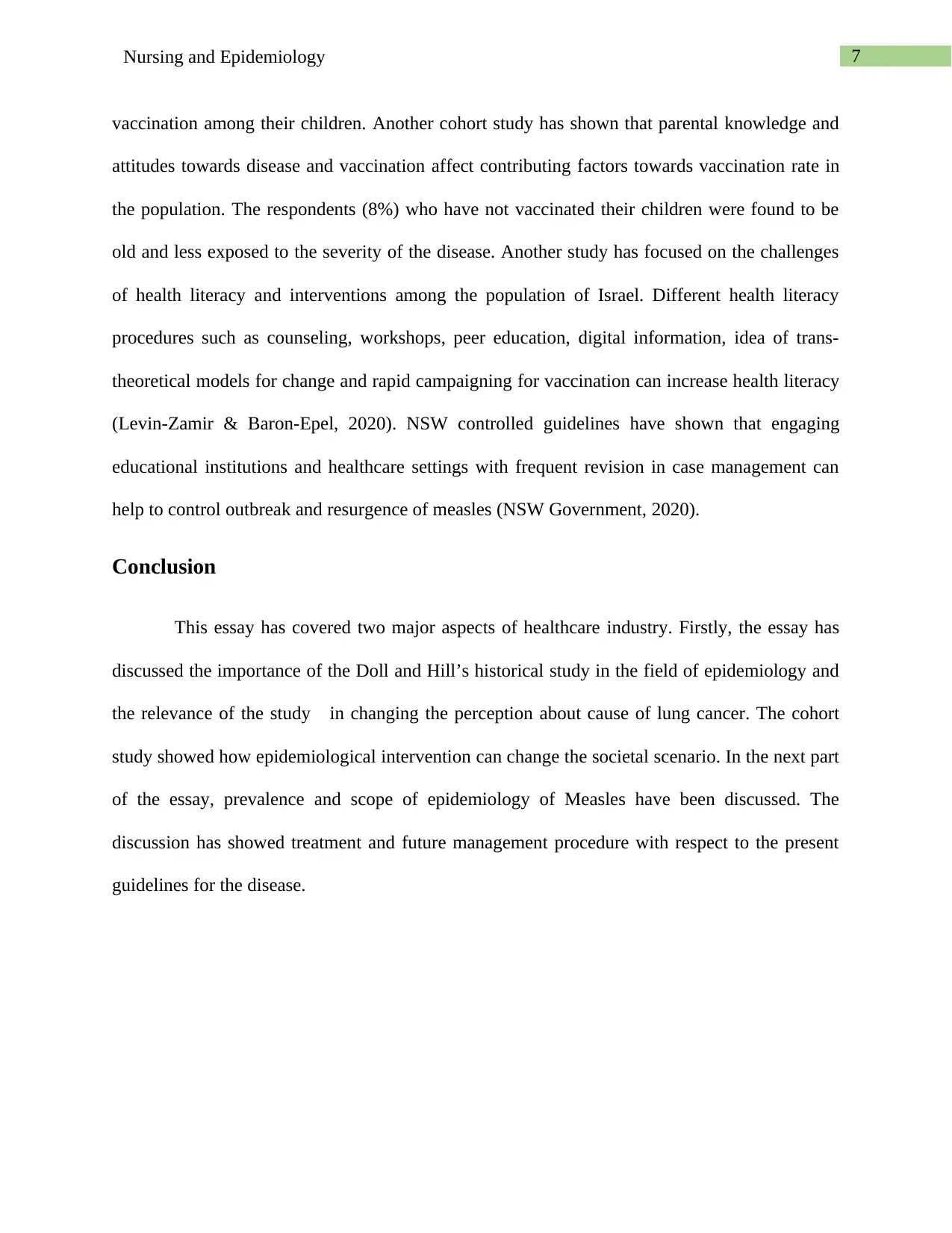
7Nursing and Epidemiology
vaccination among their children. Another cohort study has shown that parental knowledge and
attitudes towards disease and vaccination affect contributing factors towards vaccination rate in
the population. The respondents (8%) who have not vaccinated their children were found to be
old and less exposed to the severity of the disease. Another study has focused on the challenges
of health literacy and interventions among the population of Israel. Different health literacy
procedures such as counseling, workshops, peer education, digital information, idea of trans-
theoretical models for change and rapid campaigning for vaccination can increase health literacy
(Levin-Zamir & Baron-Epel, 2020). NSW controlled guidelines have shown that engaging
educational institutions and healthcare settings with frequent revision in case management can
help to control outbreak and resurgence of measles (NSW Government, 2020).
Conclusion
This essay has covered two major aspects of healthcare industry. Firstly, the essay has
discussed the importance of the Doll and Hill’s historical study in the field of epidemiology and
the relevance of the study in changing the perception about cause of lung cancer. The cohort
study showed how epidemiological intervention can change the societal scenario. In the next part
of the essay, prevalence and scope of epidemiology of Measles have been discussed. The
discussion has showed treatment and future management procedure with respect to the present
guidelines for the disease.
vaccination among their children. Another cohort study has shown that parental knowledge and
attitudes towards disease and vaccination affect contributing factors towards vaccination rate in
the population. The respondents (8%) who have not vaccinated their children were found to be
old and less exposed to the severity of the disease. Another study has focused on the challenges
of health literacy and interventions among the population of Israel. Different health literacy
procedures such as counseling, workshops, peer education, digital information, idea of trans-
theoretical models for change and rapid campaigning for vaccination can increase health literacy
(Levin-Zamir & Baron-Epel, 2020). NSW controlled guidelines have shown that engaging
educational institutions and healthcare settings with frequent revision in case management can
help to control outbreak and resurgence of measles (NSW Government, 2020).
Conclusion
This essay has covered two major aspects of healthcare industry. Firstly, the essay has
discussed the importance of the Doll and Hill’s historical study in the field of epidemiology and
the relevance of the study in changing the perception about cause of lung cancer. The cohort
study showed how epidemiological intervention can change the societal scenario. In the next part
of the essay, prevalence and scope of epidemiology of Measles have been discussed. The
discussion has showed treatment and future management procedure with respect to the present
guidelines for the disease.
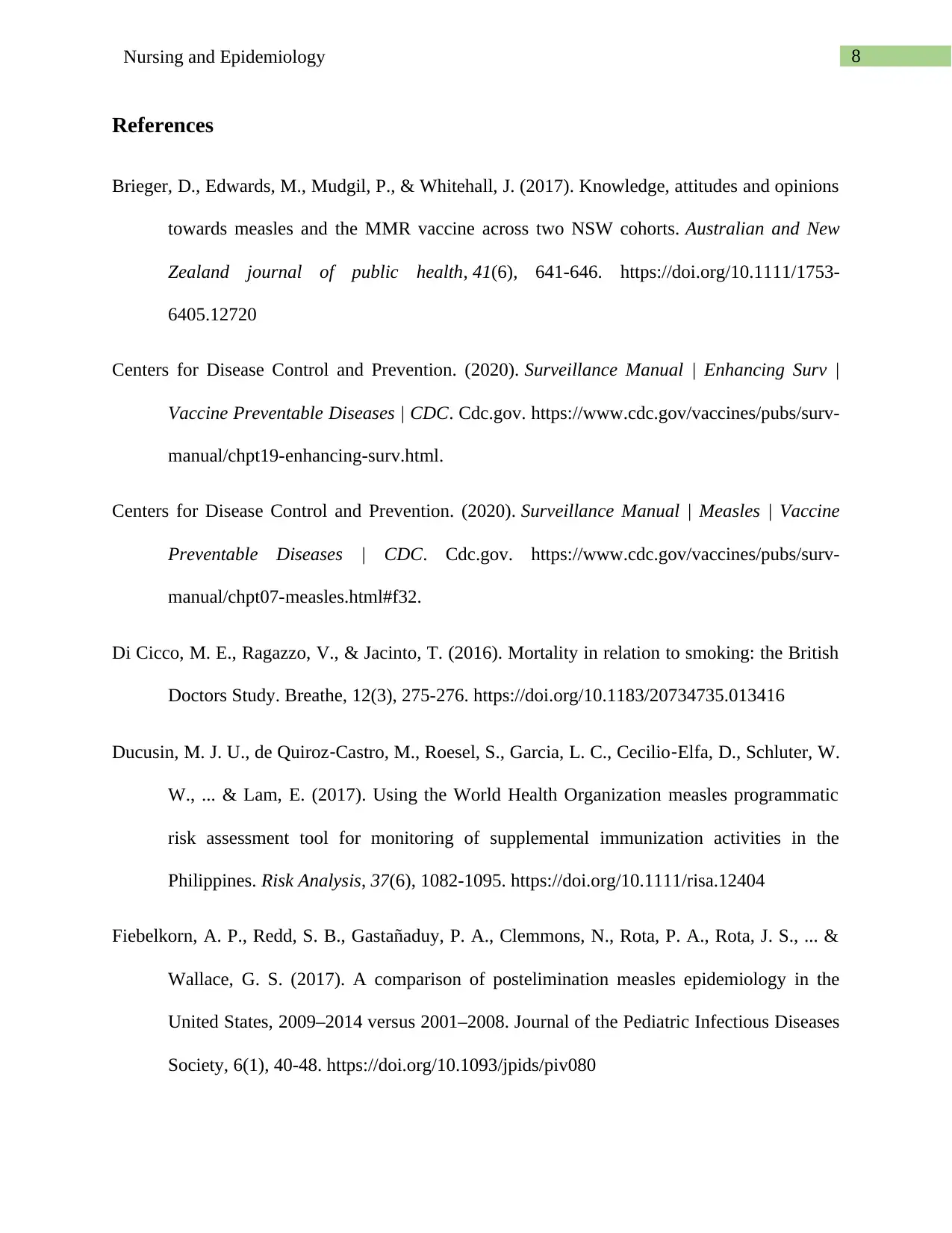
8Nursing and Epidemiology
References
Brieger, D., Edwards, M., Mudgil, P., & Whitehall, J. (2017). Knowledge, attitudes and opinions
towards measles and the MMR vaccine across two NSW cohorts. Australian and New
Zealand journal of public health, 41(6), 641-646. https://doi.org/10.1111/1753-
6405.12720
Centers for Disease Control and Prevention. (2020). Surveillance Manual | Enhancing Surv |
Vaccine Preventable Diseases | CDC. Cdc.gov. https://www.cdc.gov/vaccines/pubs/surv-
manual/chpt19-enhancing-surv.html.
Centers for Disease Control and Prevention. (2020). Surveillance Manual | Measles | Vaccine
Preventable Diseases | CDC. Cdc.gov. https://www.cdc.gov/vaccines/pubs/surv-
manual/chpt07-measles.html#f32.
Di Cicco, M. E., Ragazzo, V., & Jacinto, T. (2016). Mortality in relation to smoking: the British
Doctors Study. Breathe, 12(3), 275-276. https://doi.org/10.1183/20734735.013416
Ducusin, M. J. U., de Quiroz‐Castro, M., Roesel, S., Garcia, L. C., Cecilio‐Elfa, D., Schluter, W.
W., ... & Lam, E. (2017). Using the World Health Organization measles programmatic
risk assessment tool for monitoring of supplemental immunization activities in the
Philippines. Risk Analysis, 37(6), 1082-1095. https://doi.org/10.1111/risa.12404
Fiebelkorn, A. P., Redd, S. B., Gastañaduy, P. A., Clemmons, N., Rota, P. A., Rota, J. S., ... &
Wallace, G. S. (2017). A comparison of postelimination measles epidemiology in the
United States, 2009–2014 versus 2001–2008. Journal of the Pediatric Infectious Diseases
Society, 6(1), 40-48. https://doi.org/10.1093/jpids/piv080
References
Brieger, D., Edwards, M., Mudgil, P., & Whitehall, J. (2017). Knowledge, attitudes and opinions
towards measles and the MMR vaccine across two NSW cohorts. Australian and New
Zealand journal of public health, 41(6), 641-646. https://doi.org/10.1111/1753-
6405.12720
Centers for Disease Control and Prevention. (2020). Surveillance Manual | Enhancing Surv |
Vaccine Preventable Diseases | CDC. Cdc.gov. https://www.cdc.gov/vaccines/pubs/surv-
manual/chpt19-enhancing-surv.html.
Centers for Disease Control and Prevention. (2020). Surveillance Manual | Measles | Vaccine
Preventable Diseases | CDC. Cdc.gov. https://www.cdc.gov/vaccines/pubs/surv-
manual/chpt07-measles.html#f32.
Di Cicco, M. E., Ragazzo, V., & Jacinto, T. (2016). Mortality in relation to smoking: the British
Doctors Study. Breathe, 12(3), 275-276. https://doi.org/10.1183/20734735.013416
Ducusin, M. J. U., de Quiroz‐Castro, M., Roesel, S., Garcia, L. C., Cecilio‐Elfa, D., Schluter, W.
W., ... & Lam, E. (2017). Using the World Health Organization measles programmatic
risk assessment tool for monitoring of supplemental immunization activities in the
Philippines. Risk Analysis, 37(6), 1082-1095. https://doi.org/10.1111/risa.12404
Fiebelkorn, A. P., Redd, S. B., Gastañaduy, P. A., Clemmons, N., Rota, P. A., Rota, J. S., ... &
Wallace, G. S. (2017). A comparison of postelimination measles epidemiology in the
United States, 2009–2014 versus 2001–2008. Journal of the Pediatric Infectious Diseases
Society, 6(1), 40-48. https://doi.org/10.1093/jpids/piv080
⊘ This is a preview!⊘
Do you want full access?
Subscribe today to unlock all pages.

Trusted by 1+ million students worldwide
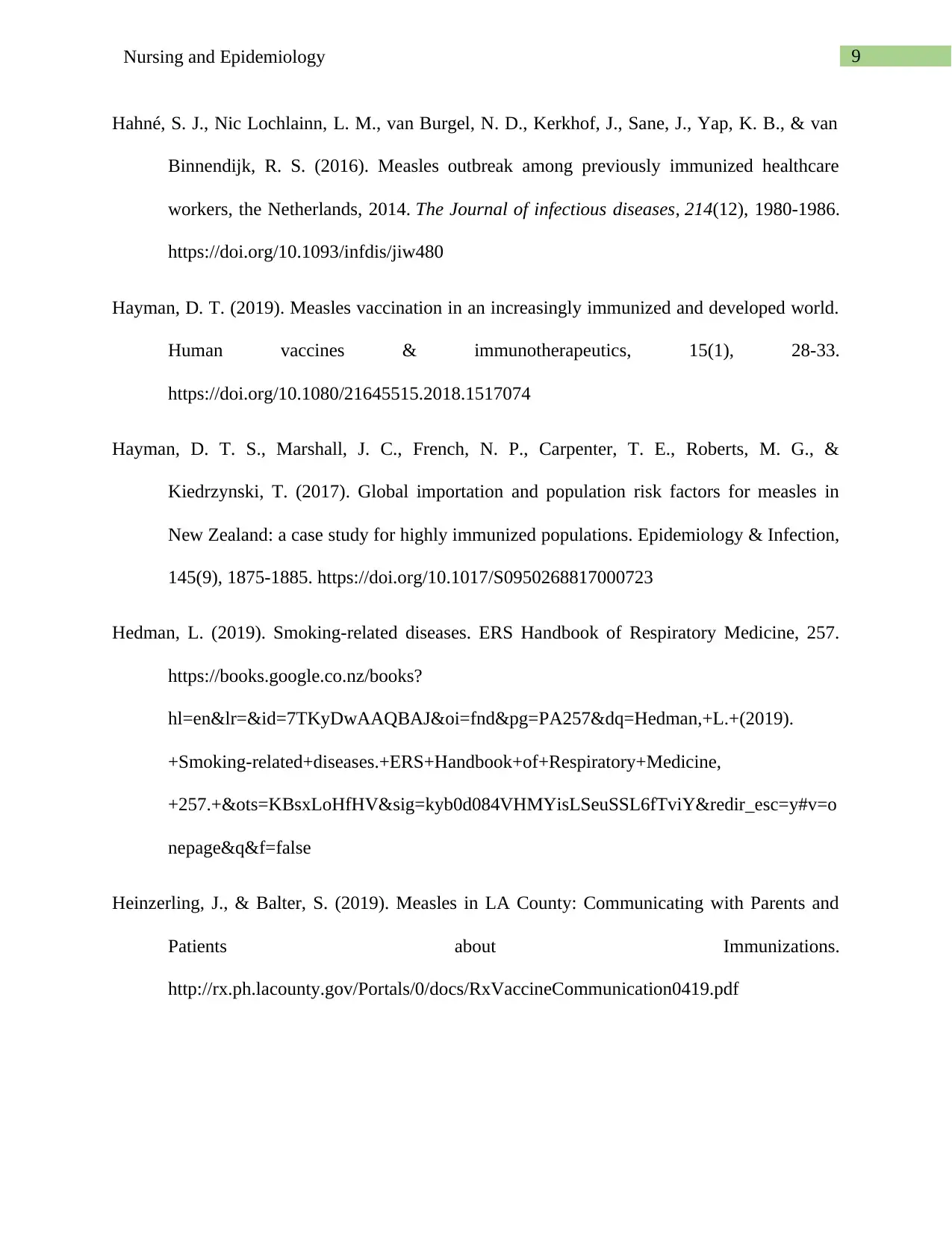
9Nursing and Epidemiology
Hahné, S. J., Nic Lochlainn, L. M., van Burgel, N. D., Kerkhof, J., Sane, J., Yap, K. B., & van
Binnendijk, R. S. (2016). Measles outbreak among previously immunized healthcare
workers, the Netherlands, 2014. The Journal of infectious diseases, 214(12), 1980-1986.
https://doi.org/10.1093/infdis/jiw480
Hayman, D. T. (2019). Measles vaccination in an increasingly immunized and developed world.
Human vaccines & immunotherapeutics, 15(1), 28-33.
https://doi.org/10.1080/21645515.2018.1517074
Hayman, D. T. S., Marshall, J. C., French, N. P., Carpenter, T. E., Roberts, M. G., &
Kiedrzynski, T. (2017). Global importation and population risk factors for measles in
New Zealand: a case study for highly immunized populations. Epidemiology & Infection,
145(9), 1875-1885. https://doi.org/10.1017/S0950268817000723
Hedman, L. (2019). Smoking-related diseases. ERS Handbook of Respiratory Medicine, 257.
https://books.google.co.nz/books?
hl=en&lr=&id=7TKyDwAAQBAJ&oi=fnd&pg=PA257&dq=Hedman,+L.+(2019).
+Smoking-related+diseases.+ERS+Handbook+of+Respiratory+Medicine,
+257.+&ots=KBsxLoHfHV&sig=kyb0d084VHMYisLSeuSSL6fTviY&redir_esc=y#v=o
nepage&q&f=false
Heinzerling, J., & Balter, S. (2019). Measles in LA County: Communicating with Parents and
Patients about Immunizations.
http://rx.ph.lacounty.gov/Portals/0/docs/RxVaccineCommunication0419.pdf
Hahné, S. J., Nic Lochlainn, L. M., van Burgel, N. D., Kerkhof, J., Sane, J., Yap, K. B., & van
Binnendijk, R. S. (2016). Measles outbreak among previously immunized healthcare
workers, the Netherlands, 2014. The Journal of infectious diseases, 214(12), 1980-1986.
https://doi.org/10.1093/infdis/jiw480
Hayman, D. T. (2019). Measles vaccination in an increasingly immunized and developed world.
Human vaccines & immunotherapeutics, 15(1), 28-33.
https://doi.org/10.1080/21645515.2018.1517074
Hayman, D. T. S., Marshall, J. C., French, N. P., Carpenter, T. E., Roberts, M. G., &
Kiedrzynski, T. (2017). Global importation and population risk factors for measles in
New Zealand: a case study for highly immunized populations. Epidemiology & Infection,
145(9), 1875-1885. https://doi.org/10.1017/S0950268817000723
Hedman, L. (2019). Smoking-related diseases. ERS Handbook of Respiratory Medicine, 257.
https://books.google.co.nz/books?
hl=en&lr=&id=7TKyDwAAQBAJ&oi=fnd&pg=PA257&dq=Hedman,+L.+(2019).
+Smoking-related+diseases.+ERS+Handbook+of+Respiratory+Medicine,
+257.+&ots=KBsxLoHfHV&sig=kyb0d084VHMYisLSeuSSL6fTviY&redir_esc=y#v=o
nepage&q&f=false
Heinzerling, J., & Balter, S. (2019). Measles in LA County: Communicating with Parents and
Patients about Immunizations.
http://rx.ph.lacounty.gov/Portals/0/docs/RxVaccineCommunication0419.pdf
Paraphrase This Document
Need a fresh take? Get an instant paraphrase of this document with our AI Paraphraser
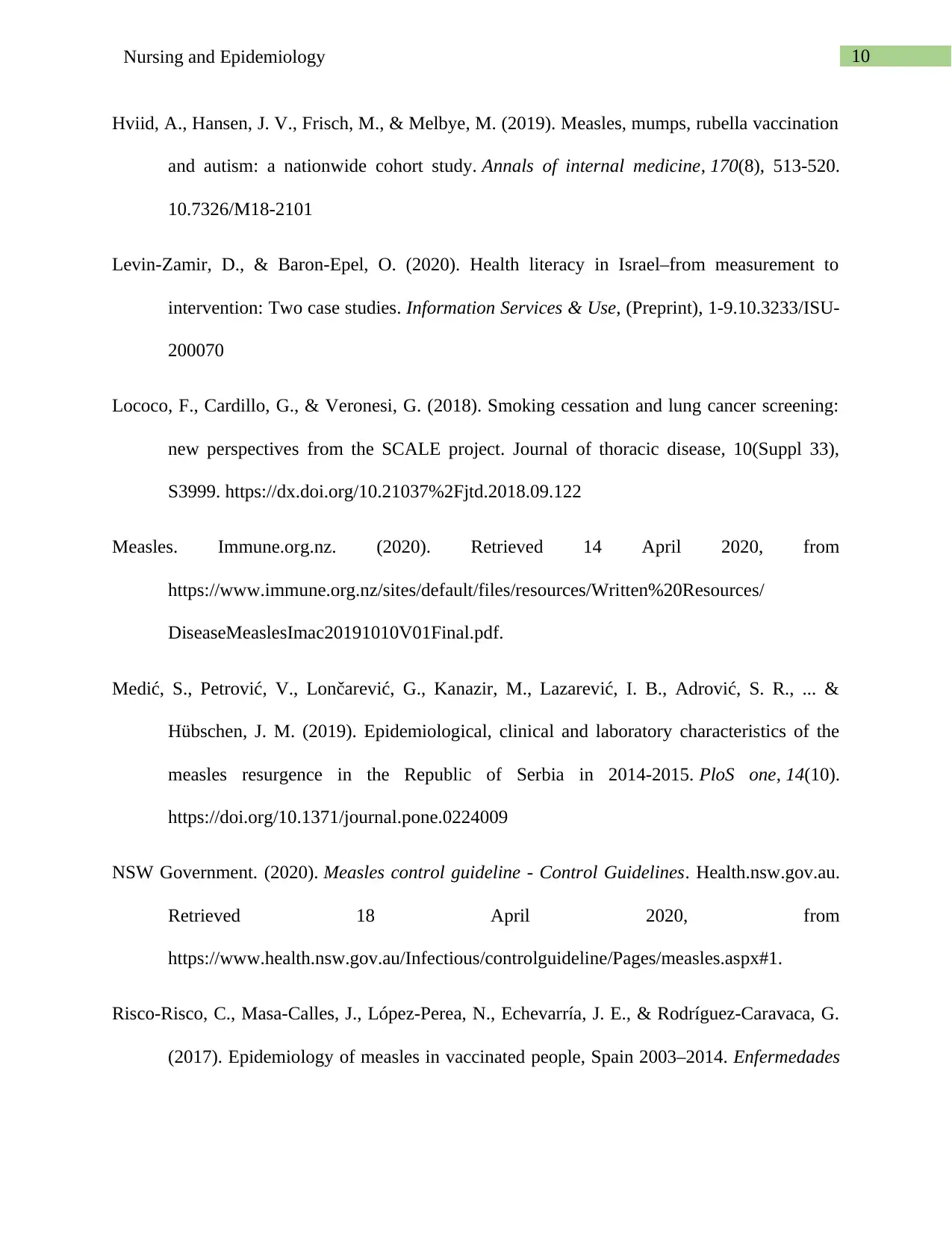
10Nursing and Epidemiology
Hviid, A., Hansen, J. V., Frisch, M., & Melbye, M. (2019). Measles, mumps, rubella vaccination
and autism: a nationwide cohort study. Annals of internal medicine, 170(8), 513-520.
10.7326/M18-2101
Levin-Zamir, D., & Baron-Epel, O. (2020). Health literacy in Israel–from measurement to
intervention: Two case studies. Information Services & Use, (Preprint), 1-9.10.3233/ISU-
200070
Lococo, F., Cardillo, G., & Veronesi, G. (2018). Smoking cessation and lung cancer screening:
new perspectives from the SCALE project. Journal of thoracic disease, 10(Suppl 33),
S3999. https://dx.doi.org/10.21037%2Fjtd.2018.09.122
Measles. Immune.org.nz. (2020). Retrieved 14 April 2020, from
https://www.immune.org.nz/sites/default/files/resources/Written%20Resources/
DiseaseMeaslesImac20191010V01Final.pdf.
Medić, S., Petrović, V., Lončarević, G., Kanazir, M., Lazarević, I. B., Adrović, S. R., ... &
Hübschen, J. M. (2019). Epidemiological, clinical and laboratory characteristics of the
measles resurgence in the Republic of Serbia in 2014-2015. PloS one, 14(10).
https://doi.org/10.1371/journal.pone.0224009
NSW Government. (2020). Measles control guideline - Control Guidelines. Health.nsw.gov.au.
Retrieved 18 April 2020, from
https://www.health.nsw.gov.au/Infectious/controlguideline/Pages/measles.aspx#1.
Risco-Risco, C., Masa-Calles, J., López-Perea, N., Echevarría, J. E., & Rodríguez-Caravaca, G.
(2017). Epidemiology of measles in vaccinated people, Spain 2003–2014. Enfermedades
Hviid, A., Hansen, J. V., Frisch, M., & Melbye, M. (2019). Measles, mumps, rubella vaccination
and autism: a nationwide cohort study. Annals of internal medicine, 170(8), 513-520.
10.7326/M18-2101
Levin-Zamir, D., & Baron-Epel, O. (2020). Health literacy in Israel–from measurement to
intervention: Two case studies. Information Services & Use, (Preprint), 1-9.10.3233/ISU-
200070
Lococo, F., Cardillo, G., & Veronesi, G. (2018). Smoking cessation and lung cancer screening:
new perspectives from the SCALE project. Journal of thoracic disease, 10(Suppl 33),
S3999. https://dx.doi.org/10.21037%2Fjtd.2018.09.122
Measles. Immune.org.nz. (2020). Retrieved 14 April 2020, from
https://www.immune.org.nz/sites/default/files/resources/Written%20Resources/
DiseaseMeaslesImac20191010V01Final.pdf.
Medić, S., Petrović, V., Lončarević, G., Kanazir, M., Lazarević, I. B., Adrović, S. R., ... &
Hübschen, J. M. (2019). Epidemiological, clinical and laboratory characteristics of the
measles resurgence in the Republic of Serbia in 2014-2015. PloS one, 14(10).
https://doi.org/10.1371/journal.pone.0224009
NSW Government. (2020). Measles control guideline - Control Guidelines. Health.nsw.gov.au.
Retrieved 18 April 2020, from
https://www.health.nsw.gov.au/Infectious/controlguideline/Pages/measles.aspx#1.
Risco-Risco, C., Masa-Calles, J., López-Perea, N., Echevarría, J. E., & Rodríguez-Caravaca, G.
(2017). Epidemiology of measles in vaccinated people, Spain 2003–2014. Enfermedades
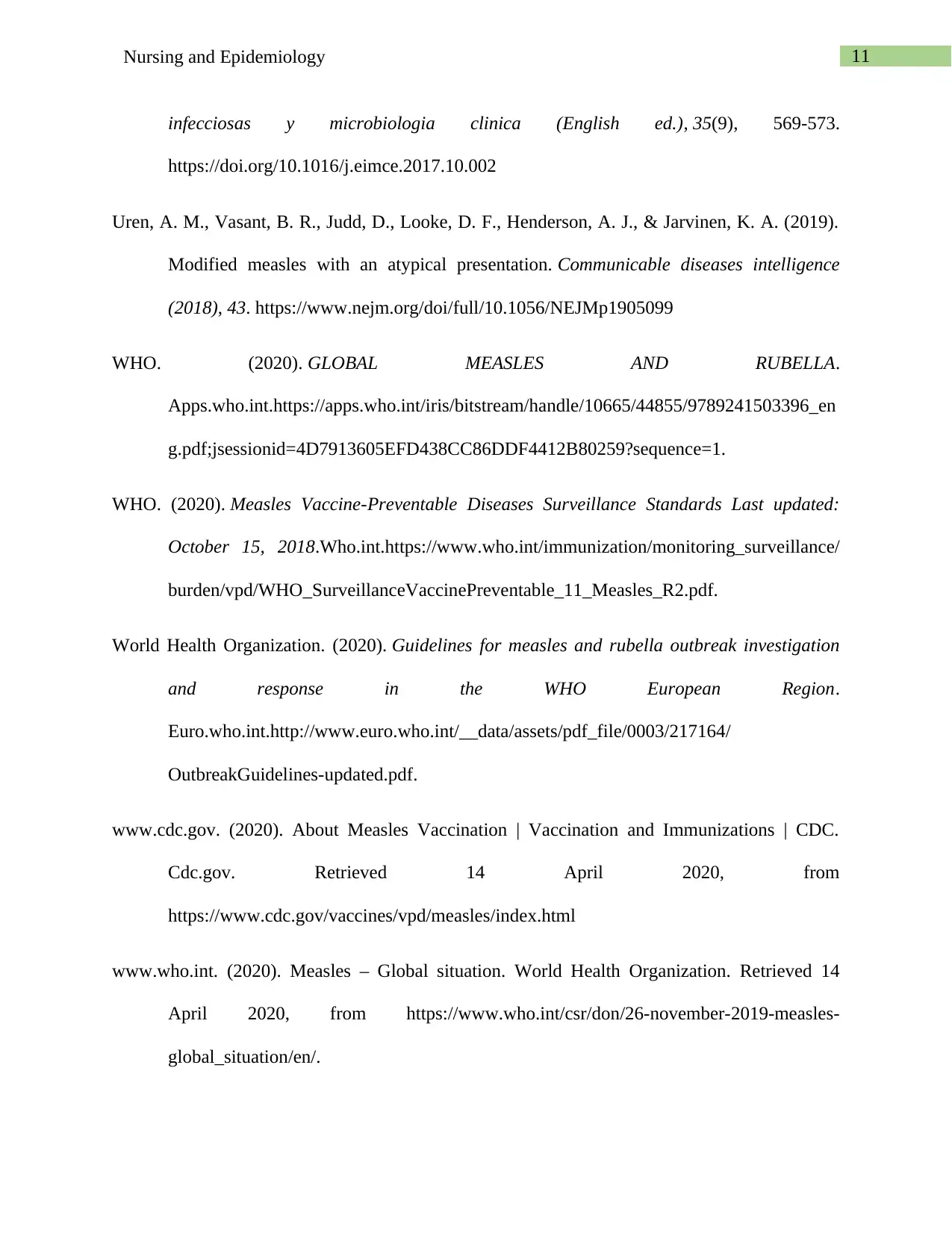
11Nursing and Epidemiology
infecciosas y microbiologia clinica (English ed.), 35(9), 569-573.
https://doi.org/10.1016/j.eimce.2017.10.002
Uren, A. M., Vasant, B. R., Judd, D., Looke, D. F., Henderson, A. J., & Jarvinen, K. A. (2019).
Modified measles with an atypical presentation. Communicable diseases intelligence
(2018), 43. https://www.nejm.org/doi/full/10.1056/NEJMp1905099
WHO. (2020). GLOBAL MEASLES AND RUBELLA.
Apps.who.int.https://apps.who.int/iris/bitstream/handle/10665/44855/9789241503396_en
g.pdf;jsessionid=4D7913605EFD438CC86DDF4412B80259?sequence=1.
WHO. (2020). Measles Vaccine-Preventable Diseases Surveillance Standards Last updated:
October 15, 2018.Who.int.https://www.who.int/immunization/monitoring_surveillance/
burden/vpd/WHO_SurveillanceVaccinePreventable_11_Measles_R2.pdf.
World Health Organization. (2020). Guidelines for measles and rubella outbreak investigation
and response in the WHO European Region.
Euro.who.int.http://www.euro.who.int/__data/assets/pdf_file/0003/217164/
OutbreakGuidelines-updated.pdf.
www.cdc.gov. (2020). About Measles Vaccination | Vaccination and Immunizations | CDC.
Cdc.gov. Retrieved 14 April 2020, from
https://www.cdc.gov/vaccines/vpd/measles/index.html
www.who.int. (2020). Measles – Global situation. World Health Organization. Retrieved 14
April 2020, from https://www.who.int/csr/don/26-november-2019-measles-
global_situation/en/.
infecciosas y microbiologia clinica (English ed.), 35(9), 569-573.
https://doi.org/10.1016/j.eimce.2017.10.002
Uren, A. M., Vasant, B. R., Judd, D., Looke, D. F., Henderson, A. J., & Jarvinen, K. A. (2019).
Modified measles with an atypical presentation. Communicable diseases intelligence
(2018), 43. https://www.nejm.org/doi/full/10.1056/NEJMp1905099
WHO. (2020). GLOBAL MEASLES AND RUBELLA.
Apps.who.int.https://apps.who.int/iris/bitstream/handle/10665/44855/9789241503396_en
g.pdf;jsessionid=4D7913605EFD438CC86DDF4412B80259?sequence=1.
WHO. (2020). Measles Vaccine-Preventable Diseases Surveillance Standards Last updated:
October 15, 2018.Who.int.https://www.who.int/immunization/monitoring_surveillance/
burden/vpd/WHO_SurveillanceVaccinePreventable_11_Measles_R2.pdf.
World Health Organization. (2020). Guidelines for measles and rubella outbreak investigation
and response in the WHO European Region.
Euro.who.int.http://www.euro.who.int/__data/assets/pdf_file/0003/217164/
OutbreakGuidelines-updated.pdf.
www.cdc.gov. (2020). About Measles Vaccination | Vaccination and Immunizations | CDC.
Cdc.gov. Retrieved 14 April 2020, from
https://www.cdc.gov/vaccines/vpd/measles/index.html
www.who.int. (2020). Measles – Global situation. World Health Organization. Retrieved 14
April 2020, from https://www.who.int/csr/don/26-november-2019-measles-
global_situation/en/.
⊘ This is a preview!⊘
Do you want full access?
Subscribe today to unlock all pages.

Trusted by 1+ million students worldwide
1 out of 13
Related Documents
Your All-in-One AI-Powered Toolkit for Academic Success.
+13062052269
info@desklib.com
Available 24*7 on WhatsApp / Email
![[object Object]](/_next/static/media/star-bottom.7253800d.svg)
Unlock your academic potential
Copyright © 2020–2025 A2Z Services. All Rights Reserved. Developed and managed by ZUCOL.




